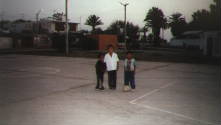
Latin American Children and Sports Activities
The healthy development of children is premised on both mental and physical education. In the Pan-Latin American Kids Study, we asked children in which sports activities they like to play. The following chart shows the percent for the top 5 sports activities among children between the ages of 7 and 11 in the 19 surveyed countries in 1996.

SOCCER Here is a quotation from a column in the
newspaper La República in Costa Rica: "Soccer is not the sport of Costa
Ricans. It is the motor of their existence. Soccer in Costa Rica is escape, pastime,
purification, ecstasy, mania, bread, and necessary illusion. And since ours is a people
frustrated in many areas, it seeks in soccer the consummation of its longings, the kingdom
of happiness, success."
Given the diversity of people and culture in Latin America, is soccer the universally
preferred sport everywhere? According to the next chart, the answer is virtually
everywhere, with the exception of Venezuela and Puerto Rico, a subject that we will return
to.

The attractions of soccer for Latin Americans are manifold. First of all, this is a sport in which they have historically excelled in the world, with world championships being won by Argentina and Brazil in recent years. In the soccer-mad countries, stars such as Ronaldinho, Roberto Carlos, Romario, Marco Etcheverry, Jorge Campos, Luis Hernandez, etc. are idolized and emulated by fans, young and old.
At the grassroots level, soccer is popular because the sport can be played virtually anywhere with any equipment. Soccer does not have to be played only with a regulation leatherskin ball, but it can be played with any object --- leather, plastic, rubber, paper, and whatever the imagination can lead to. Soccer can be played alone or with others. The regulation game is played with eleven people per side. A popular variant known as indoor, which is invariably played outdoors, has six players per side. Pickup games can have any number of people and even dogs. Soccer does not have to played on a regulation grass field, but it can be played on asphalt surfaces, concrete surfaces, dirt surfaces, sidewalks and ... yes, even on basketball courts:-

Picture of three children in Lima, Peru
playing soccer on a concrete basketball court
(photo credit: Deborah Levy)
BASEBALL: Why is the preference of soccer low among children in Puerto Rico and Venezuela? That is because the children there prefer another sport: béisbol. In these two places, baseball mania is at the same level for soccer elsewhere in Latin America. Many players from these countries play in the US Major League Baseball, including stars such as Sammy Sosa, Roberto Alomar, Bobby Bonilla, Andres Galarraga, and Bernie Williams. In the winter, both Puerto Rico and Venezuela have baseball leagues in which present and future major leagues players come to hone their skills.

BASKETBALL: Perhaps the sport that is most uniformly popular across all countries is basketball, as shown in the chart below. The credit must be given in no small part to the National Basketball Association (NBA) in running a global marketing campaign to promote the sport. Names such as Michael Jordan, Dennis Rodman, Shaquille O'Neal and Patrick Ewing are household names all over the world. During the 1996-1997 NBA season, over 550 million households in 188 countries worldwide were able to watch NBA games on their national broadcast stations.

VOLLEYBALL While volleyball is the
second most popular sport among kids in Latin America, we should note that different forms
of the sport is practiced. The traditional volleyball game is played in an indoor
auditorium with six players per side. A very popular variant is beach volleyball, being
played by two or four players per side on sand, with Brazilians being strong players.
Recreationally, there is a variant of volleyball known sometimes as Ecuavolley,
because of its popularity in Ecuador. There, the net is lower and the players hit the ball
with a 'carry' motion that would have been declared a foul under the international rules.
However, the relaxation of the rules meant that you don't have to be a 6'6" hunk to
play the game.
SWIMMING Swimming is a sport which depends on the availability of water. In some places, there are no natural swimming areas nor is the weather favorable. For example, there is not much chance of outdoor swimming in La Paz, Bolivia. But Latin America has some of the most breathtakingly beautiful beaches in the world. Here are the photographs of three famous beaches (note: yes, in case you are wondering, there are some perks that come with the job).
Ipanema, Rio de Janeiro, Brazil (photo credit: Pablo Verdin)
Miraflores, Lima, Peru (photo credit: Roland Soong)
San Juan, Puerto Rico (photo credit: Pablo Verdin)
(posted by Roland Soong on 11/10/97)
(Return to Zona Latina's Home Page)